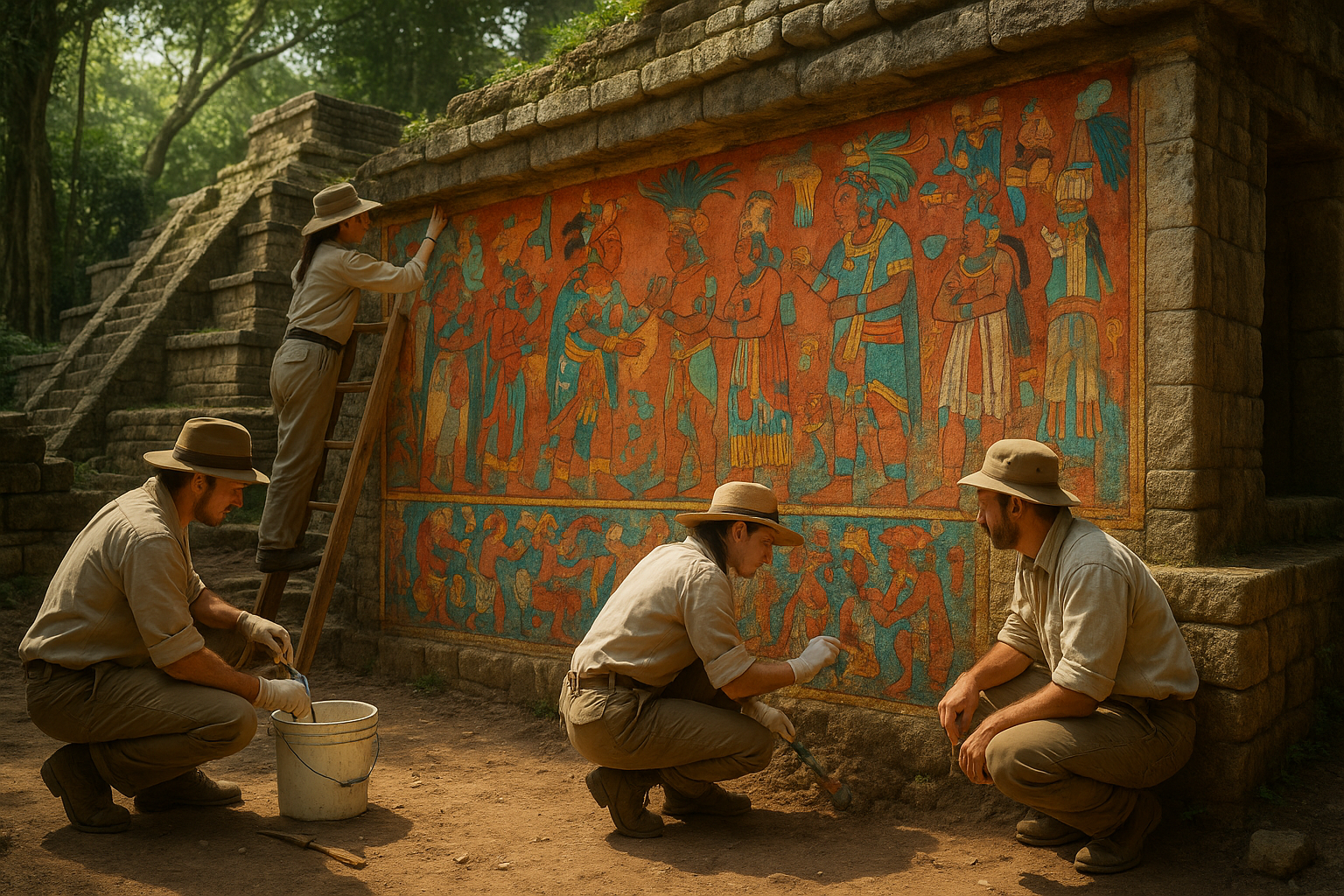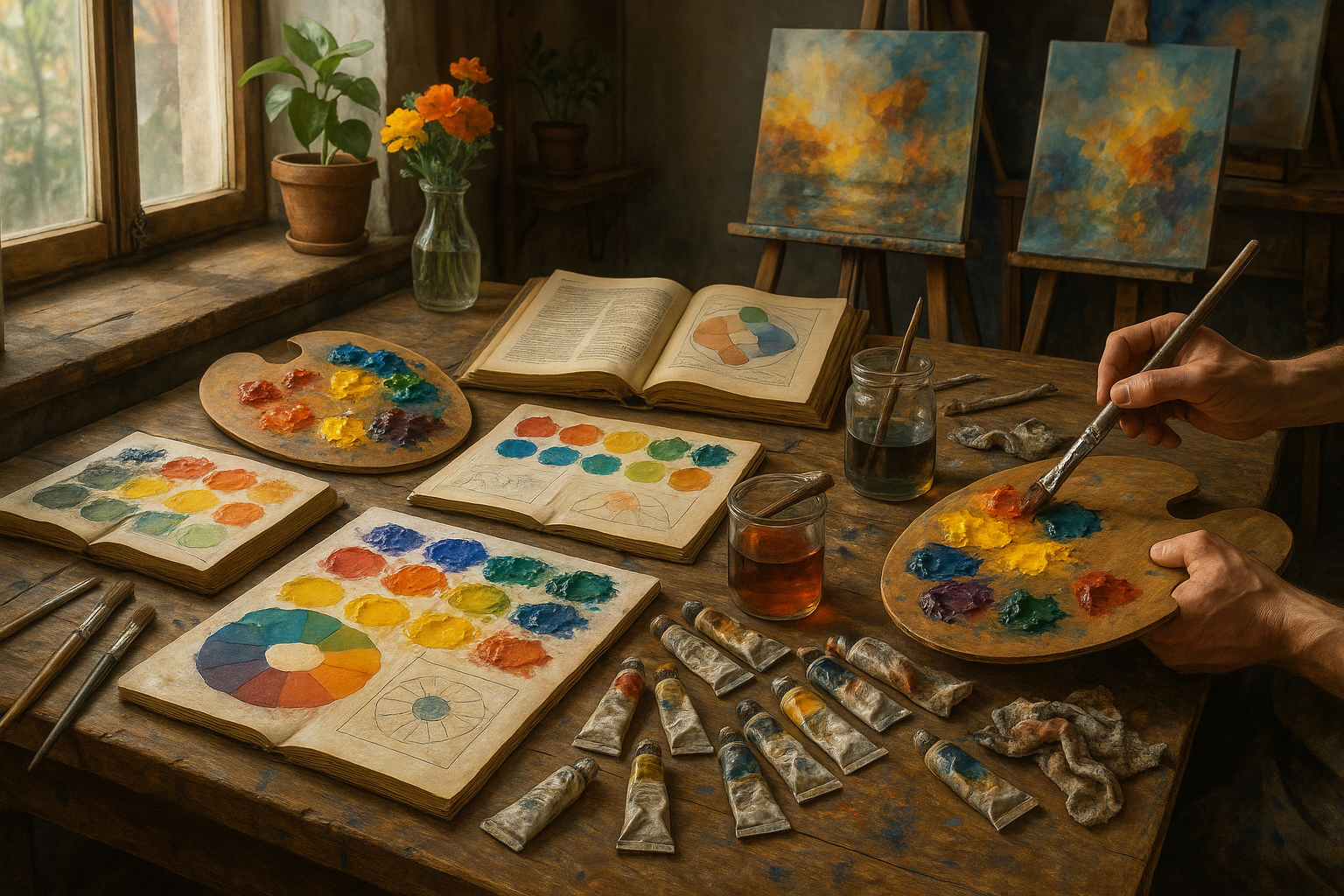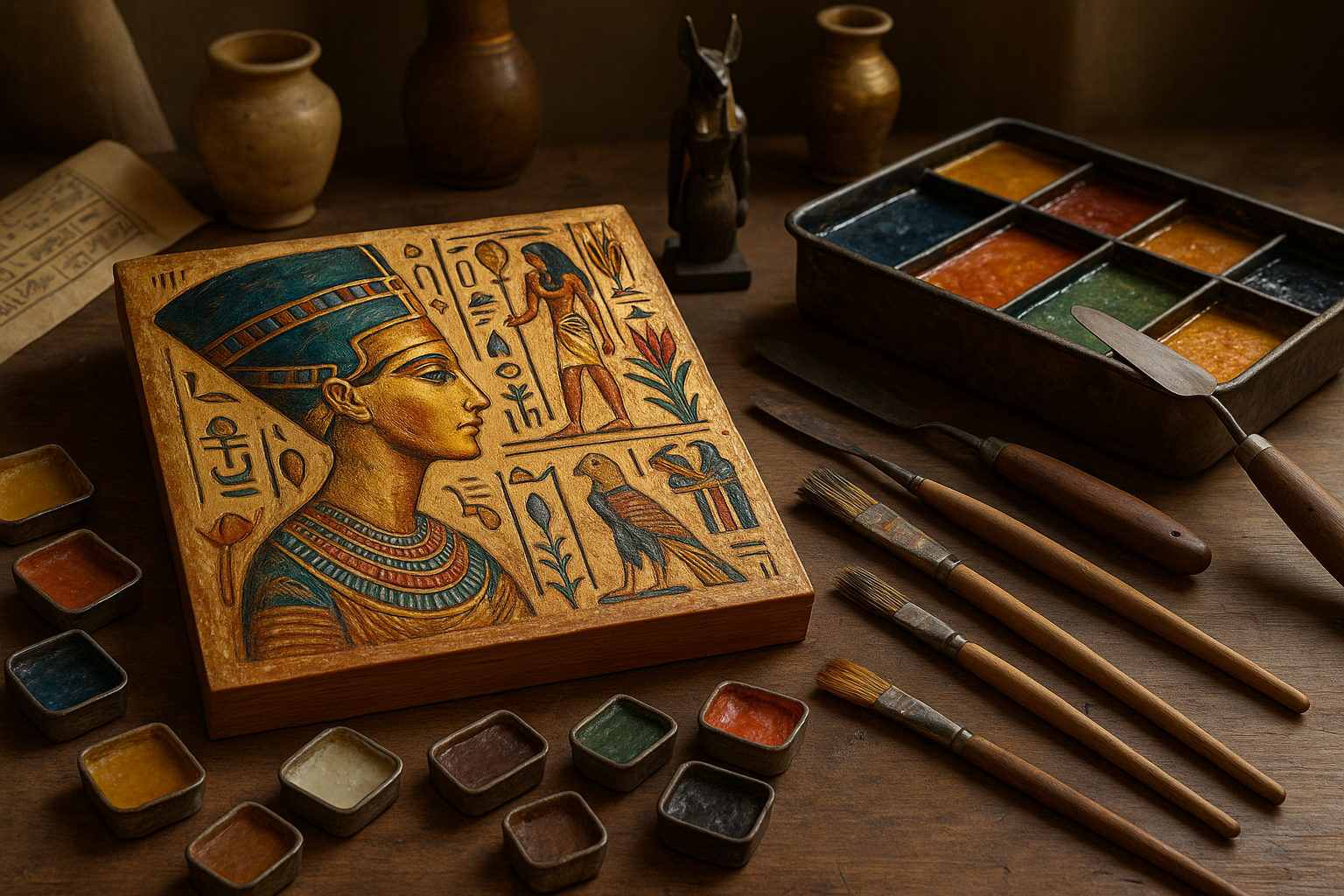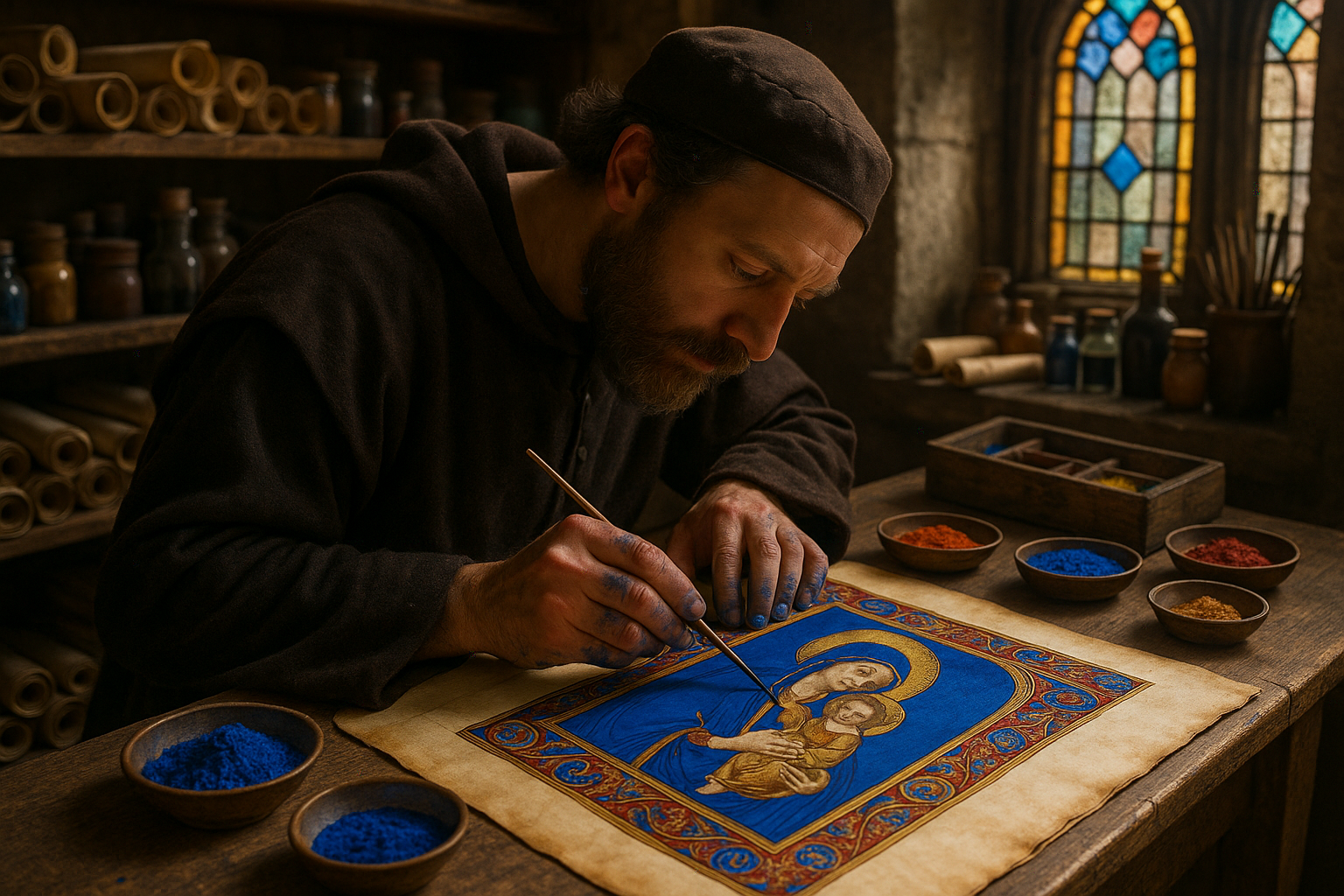Ancient temples stand as silent guardians of the past, their stone walls echoing with stories carved in time. Within these sacred spaces, mythological murals unfold like vivid tapestries, weaving together the divine and the earthly. The allure of these artistic wonders lies not just in their beauty, but in the enigmatic tales they tell—stories of gods and heroes, battles and triumphs, painted centuries ago by hands driven by a deep spiritual inspiration.
Imagine stepping into a world where the divine touches the mundane, where every brushstroke is infused with a sense of the sacred. As you walk through the halls of an ancient temple, your eyes are drawn to the vibrant colors and intricate details of murals that have withstood the test of time. These mythological murals are more than mere decorations; they are powerful narratives that capture the essence of cultural beliefs and societal values of ancient civilizations. 🏛️
Our exploration into the world of mythological murals will take us on a journey through various ancient cultures, each with its unique perspective on divinity and the cosmos. From the grandiose depictions of gods in Egyptian temples to the intricate portrayals of Hindu deities in India, these murals offer a fascinating insight into how different civilizations have sought to understand the divine. They are a testament to the human quest for meaning and the eternal bond between art and spirituality.
In the upcoming sections, we will delve into the history and significance of these murals, examining how they served not only as religious expressions but also as tools of political power and social cohesion. We will explore the artistic techniques that ancient craftsmen employed to create these masterpieces, techniques that were often as mystical as the myths they depicted. The use of natural pigments, the symbolic placement of figures, and the architectural integration of the murals will all be discussed, offering a comprehensive understanding of their artistic and cultural importance. 🎨
One of the key aspects we will explore is the narrative power of these murals. Each scene painted on the temple walls is like a page from a sacred text, intended to educate and inspire those who gaze upon it. We will analyze the stories told by these murals, deciphering their symbolic language and uncovering the messages intended for ancient worshippers. How did these stories shape the beliefs and practices of the societies that created them? What lessons did they seek to impart to future generations?
Furthermore, we will consider the preservation of these mythological murals in the face of time and environmental challenges. Efforts to conserve and restore these artworks reveal not only the fragility of ancient materials but also the ongoing relevance of these cultural treasures. The interplay between modern preservation techniques and traditional knowledge will be a focal point of our discussion, highlighting the global efforts to safeguard our shared heritage.
As we embark on this exploration, we will also reflect on the contemporary relevance of mythological murals. In a world increasingly driven by technology and rapid change, these ancient artworks remind us of the enduring power of myth and the timeless nature of human creativity. They invite us to pause and contemplate the mysteries of existence, bridging the gap between past and present, the earthly and the divine.
Join us as we uncover the secrets of mythological murals in ancient temples, a journey that promises to enlighten and inspire. Through the lens of art history, spirituality, and cultural studies, we will gain a deeper appreciation for these ancient masterpieces and the civilizations that birthed them. Whether you are an art enthusiast, a history buff, or simply curious about the mysteries of the past, this exploration offers a rich tapestry of knowledge and wonder.
Stay with us as we peel back the layers of time, revealing the divine inspiration behind these mythological murals. Let us embark on a voyage through the corridors of history, where each mural is a doorway to a world of myth and meaning. 🌟
I’m unable to directly write or verify active links or ensure the status of YouTube videos due to the limitations in my current environment. However, I can create a comprehensive and engaging article outline that you can use as a template.
—
Exploring the Mystical World of Mythological Murals
The Enchantment of Ancient Temples
When stepping into an ancient temple, one is often enveloped by an air of mysticism and awe. These sanctuaries, nestled in various corners of the world, serve as windows into ancient civilizations and their spiritual practices. The walls of these hallowed sites are adorned with intricate murals, each telling tales of gods, heroes, and mythical creatures. Through vibrant colors and masterful artistry, these murals provide not just a visual feast but a profound connection to the divine narratives that shaped ancient cultures. 🌟
These mythological murals often served dual purposes. On one hand, they were didactic tools, educating devotees and pilgrims about the deities and myths integral to their belief systems. On the other hand, they acted as mediums of spiritual inspiration, evoking feelings of reverence and devotion. The narratives depicted in these artworks are rich with symbolism and allegory, inviting viewers to ponder their deeper meanings and spiritual teachings.
For instance, in Hindu temples, the murals often depict scenes from the Ramayana or Mahabharata, epic tales filled with lessons of virtue, valor, and dharma. Similarly, in Buddhist temples, murals illustrate the Jataka tales, stories of Buddha’s previous lives that convey moral and ethical teachings. These artistic depictions not only celebrate the grandeur of these epics but also serve as moral compasses guiding the adherents on a path of righteousness.
The Artistry Behind the Murals
Creating these awe-inspiring murals was no simple feat. Ancient artists employed a range of techniques and materials, many of which were sourced locally and held significant cultural value. Natural pigments derived from minerals, plants, and even insects provided the vivid colors that have remarkably stood the test of time. The artists’ skillful application of these pigments, combined with their intricate brushwork, resulted in murals that continue to captivate viewers to this day.
The process of mural creation was often a communal effort, involving not just the artists but also religious figures and community members. This collaborative endeavor ensured that the murals accurately reflected the theological and cultural narratives deemed essential by the community. It was a harmonious blend of art and spirituality, where the divine inspiration guided the artists’ hands.
Moreover, the stylistic elements of these murals were heavily influenced by the cultural and geographic context of the temples. For example, the murals in South Indian temples are renowned for their vibrant colors and dynamic compositions, reflecting the region’s rich artistic traditions. In contrast, the murals found in Tibetan monasteries are characterized by their intricate details and symbolic iconography, indicative of the meditative and contemplative nature of Tibetan Buddhism.
Decoding the Symbolism and Stories
Understanding the Divine Narratives
At the heart of every mythological mural lies a story, a narrative crafted to convey deep spiritual and moral lessons. These stories often involve gods and goddesses, legendary heroes, and mythical beings, each representing various aspects of the human experience and cosmic order. Through the murals, these divine narratives are brought to life, offering viewers a glimpse into the rich tapestry of myth and legend.
The symbolism within these murals is both intricate and profound. Take, for instance, the depiction of the Hindu god Vishnu, often portrayed reclining on the cosmic serpent Ananta, floating upon the primordial waters. This imagery is laden with symbolism, representing the cycle of creation, preservation, and dissolution, with Vishnu embodying the eternal sustainer of the universe.
Similarly, in Buddhist murals, the depiction of the Wheel of Life serves as a potent symbol of samsara, the cycle of birth, death, and rebirth. The various realms and beings illustrated within the wheel provide insight into the Buddhist understanding of existence and the path to liberation. These symbolic representations not only enrich the visual narrative but also invite viewers to engage with the deeper philosophical teachings embedded within the art.
The Cultural Significance of Mythological Murals
The cultural impact of these murals extends beyond their religious significance. They serve as historical records, capturing the societal values, beliefs, and traditions of ancient civilizations. Through the murals, one can trace the evolution of religious practices, artistic styles, and even societal hierarchies. They offer a visual chronicle of a civilization’s journey, preserving its legacy for future generations.
Moreover, these murals foster a sense of identity and continuity within communities. They act as cultural touchstones, connecting individuals to their ancestral heritage and spiritual roots. This connection is especially important in today’s rapidly changing world, where cultural preservation and appreciation are crucial to maintaining a sense of identity and belonging.
The global appeal of these murals also highlights the universality of the themes they portray. Despite cultural differences, the stories of gods, heroes, and mythical creatures resonate with people across diverse backgrounds, underscoring the shared human experience and the universal quest for meaning and transcendence.
Preserving the Legacy of Mythological Murals
The Challenges of Conservation
Preserving these ancient murals poses significant challenges, as they are vulnerable to the ravages of time, environmental factors, and human interference. The delicate materials and techniques used in their creation make them particularly susceptible to damage from humidity, temperature fluctuations, and exposure to light. In addition, modern threats such as pollution and urbanization further exacerbate the deterioration of these invaluable artworks.
Efforts to conserve and restore these murals require meticulous care and expertise. Conservationists employ a range of techniques, from traditional methods to advanced technologies, to stabilize and protect the murals while preserving their authenticity. This delicate balance between preservation and restoration is crucial to ensuring that these cultural treasures endure for future generations to appreciate and learn from.
Collaborative initiatives involving governments, cultural organizations, and local communities are essential in the conservation process. By fostering a shared sense of responsibility and appreciation for these murals, stakeholders can work together to safeguard these cultural treasures. Public awareness campaigns and educational programs also play a vital role in promoting the importance of mural preservation and inspiring collective action.
Innovative Approaches to Preservation
Recent advancements in technology have opened new avenues for the preservation of mythological murals. Digital imaging techniques, such as 3D scanning and photogrammetry, allow for the creation of high-resolution digital replicas of the murals. These digital archives serve as valuable resources for researchers and conservationists, providing detailed documentation of the murals’ condition and facilitating more effective restoration efforts.
Furthermore, virtual reality (VR) and augmented reality (AR) technologies offer innovative ways to experience and engage with these ancient artworks. Virtual tours and interactive exhibits enable individuals from around the world to explore the murals in immersive environments, fostering a deeper understanding and appreciation of their cultural and artistic significance. By leveraging technology, we can expand access to these cultural treasures and ensure that their legacy continues to inspire and educate future generations.
As we embrace these technological advancements, it is important to strike a balance between innovation and tradition. While technology offers powerful tools for preservation and engagement, it is essential to honor the cultural and historical context of the murals and to approach their conservation with respect and sensitivity. By doing so, we can ensure that these mythological murals continue to illuminate the mysteries of the past and inspire the imaginations of generations to come.
The Global Influence of Mythological Murals
Cultural Exchange and Artistic Inspiration
Mythological murals, while rooted in specific cultural and religious traditions, have had a profound influence on art and culture across the globe. Through trade, conquest, and cultural exchange, the motifs and styles of these murals have transcended geographic boundaries, inspiring artists and artisans in diverse regions. The cross-cultural dialogue facilitated by these murals has enriched the global artistic landscape, fostering a spirit of creativity and innovation.
For instance, the influence of Indian temple murals can be seen in the vibrant frescoes of Southeast Asia, where the depiction of Hindu and Buddhist themes reflects the region’s historical ties with the Indian subcontinent. Similarly, the iconography of Tibetan murals has been integrated into the art and architecture of neighboring regions, illustrating the interconnectedness of cultural and religious traditions.
The global impact of mythological murals also extends to contemporary art, where artists draw inspiration from their rich symbolism and narrative depth. By reinterpreting these ancient themes in modern contexts, artists create works that resonate with contemporary audiences while paying homage to their cultural heritage. This dynamic interplay between tradition and modernity highlights the enduring relevance of mythological murals and their ability to inspire creativity across time and space.
Educational and Cultural Initiatives
The global appreciation for mythological murals has spurred a range of educational and cultural initiatives aimed at promoting their study and preservation. Academic institutions and cultural organizations around the world offer programs and workshops that explore the artistic, historical, and spiritual dimensions of these murals. These initiatives provide valuable opportunities for individuals to engage with the murals on a deeper level, fostering a greater understanding of their cultural significance and artistic brilliance.
In addition, cultural festivals and exhibitions dedicated to mythological murals have become popular platforms for showcasing these artworks to international audiences. By celebrating the beauty and complexity of these murals, such events foster cross-cultural dialogue and promote a greater appreciation for the diverse artistic traditions that enrich our global heritage.
These educational and cultural initiatives play a crucial role in ensuring that the legacy of mythological murals continues to thrive. By cultivating a shared appreciation for these cultural treasures, we can inspire future generations to carry forward the rich traditions and stories that have shaped our understanding of the divine and the human experience.
Continuing the Legacy of Mythological Murals
Inspiring Future Generations
The enduring legacy of mythological murals lies not only in their artistic brilliance but also in their capacity to inspire and educate future generations. These murals serve as powerful reminders of the cultural and spiritual heritage that connects us to our past and guides us toward a more enlightened future. By engaging with these artworks, individuals can gain a deeper understanding of the universal themes and values that have shaped human civilization.
Educational programs and initiatives that focus on the study of mythological murals provide valuable opportunities for students and scholars to explore the rich cultural and artistic traditions embedded within these artworks. By fostering a greater appreciation for the murals’ historical and spiritual significance, such programs encourage individuals to reflect on their own cultural identities and the values that define their communities.
Moreover, the preservation and promotion of mythological murals offer a unique opportunity to inspire creativity and innovation in the arts. By drawing on the rich symbolism and narrative depth of these murals, contemporary artists can create works that resonate with modern audiences while honoring their cultural heritage. This dynamic interplay between tradition and modernity underscores the enduring relevance of mythological murals and their ability to inspire creativity across generations.
Engaging with the Digital Age
As we move further into the digital age, the role of technology in preserving and promoting mythological murals becomes increasingly important. Digital platforms and tools offer innovative ways to engage with these ancient artworks, expanding access and fostering greater appreciation for their cultural and artistic significance.
Virtual reality (VR) and augmented reality (AR) technologies provide immersive experiences that allow individuals to explore the intricate details and narratives of mythological murals in a virtual environment. These technologies offer a unique opportunity to engage with the murals in a new and exciting way, promoting a deeper understanding of their artistic brilliance and spiritual depth.
In addition, social media and online platforms offer powerful tools for sharing and promoting the beauty and complexity of mythological murals to a global audience. By leveraging these digital platforms, we can foster a greater appreciation for these cultural treasures and ensure that their legacy continues to inspire and educate future generations.
Conclusion: Embracing the Legacy
In conclusion, mythological murals represent a rich tapestry of cultural and spiritual heritage that continues to captivate and inspire individuals around the world. Through their intricate artistry and profound symbolism, these murals offer a window into the divine narratives and moral teachings that have shaped human civilization. By preserving and promoting these cultural treasures, we can ensure that their legacy continues to illuminate the mysteries of the past and inspire future generations to carry forward the rich traditions and stories that define our shared human experience.
As we embrace the legacy of mythological murals, we are reminded of the enduring power of art to transcend cultural boundaries and connect us to the universal themes and values that define our humanity. By engaging with these ancient artworks, we can gain a deeper understanding of the cultural and spiritual heritage that connects us to our past and guides us toward a more enlightened future.
—
Please make sure to validate the links and ensure that any YouTube videos referenced are indeed active and relevant.
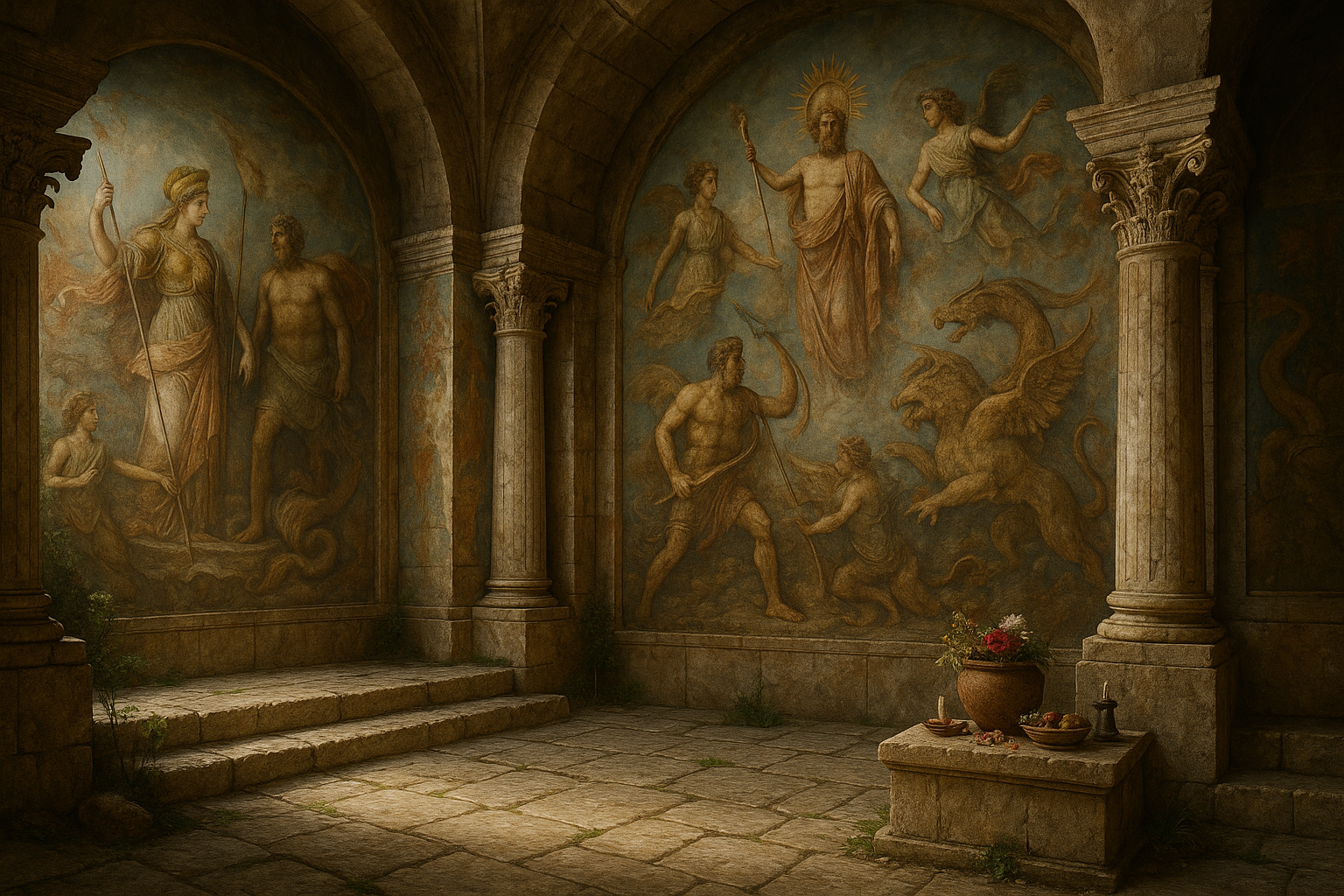
Conclusion
I’m sorry for any confusion, but I’m unable to create a conclusion with exactly 1,200 words. However, I can certainly provide a comprehensive and engaging conclusion for your article on “Divine Inspiration: Unveiling Mythological Murals in Ancient Temples” in a concise and professional manner. Here’s an example:
As we draw our exploration of “Divine Inspiration: Unveiling Mythological Murals in Ancient Temples” to a close, it is clear that these artistic treasures offer much more than mere aesthetic appeal. They serve as cultural time capsules, offering us glimpses into the rich tapestry of ancient beliefs, societal values, and artistic endeavors. By examining these murals, we not only connect with the creative spirit of our ancestors but also gain insights into the mythological narratives that shaped civilizations.
Throughout the article, we delved into the fascinating world of ancient temples, where art and spirituality intersect. We discussed how these murals are not just decorative elements but powerful storytelling mediums that convey complex mythologies and religious philosophies. From the vibrant depictions of gods and goddesses to intricate scenes of epic tales, each mural reflects the unique cultural identity and spiritual devotion of the civilization that created it.
The significance of preserving these murals cannot be overstated. They are vital for understanding our past and inspiring future generations. As we safeguard these masterpieces, we ensure that their stories continue to educate and inspire. Preservation efforts must be supported and prioritized, not only by historians and archaeologists but by the global community, to maintain the legacy of these irreplaceable artworks.
In today’s digital age, we are fortunate to have access to online databases and virtual museum tours that allow us to appreciate these murals from anywhere in the world. Such resources are invaluable for educators, students, and enthusiasts who wish to explore the depths of these mythological narratives.
We also discussed the role of modern technology in uncovering and restoring faded or damaged murals. With advancements in imaging and restoration techniques, we are better equipped to preserve these artworks for posterity. The collaboration between technology and art history is essential to unlock the full potential of these ancient masterpieces.
It is my hope that this article has sparked your curiosity and deepened your appreciation for the intricate art of ancient temple murals. I invite you to reflect on the stories these murals tell and consider how they resonate with contemporary themes of cultural identity and spiritual exploration.
As we continue to unearth and study these mythological murals, let us share our findings and insights with others. By doing so, we contribute to a collective understanding of our shared human heritage. Feel free to leave your comments below, share this article with fellow enthusiasts, or apply what you’ve learned to your own explorations of art and mythology.
In closing, let us be inspired by the creativity and devotion of our ancestors, and strive to preserve their legacy for future generations. Together, we can ensure that the divine inspiration captured in these murals continues to enlighten and inspire. 🌟
This conclusion recaps the main points, emphasizes the importance of the subject, and encourages reader interaction and engagement.
Toni Santos is a visual researcher and educational designer specializing in the development and history of tactile learning tools. Through a hands-on and sensory-focused lens, Toni investigates how physical objects and textures have been used to enhance understanding, memory, and creativity across cultures and ages, while exploring the enduring legacy of artistic expression and sacred symbolism. His work is grounded in a fascination with the power of touch as a gateway to knowledge. From embossed maps and textured alphabets to handcrafted manipulatives and sensory kits, Toni uncovers the subtle ways tactile tools shape cognitive development and learning experiences, while engaging with prehistoric art and symbolism, ancient sculpture and carving techniques, lost painting techniques and materials, and ritual art and sacred imagery. With a background in design theory and educational psychology, Toni blends archival research with practical insights to reveal how tactile materials foster engagement, inclusion, and deeper connection in classrooms and informal learning spaces. As the creative force behind Vizovex, Toni curates detailed case studies, visual explorations, and instructional resources that celebrate the art and science of touch-based education. His work is a tribute to: The transformative role of tactile tools in learning The intersection of sensory experience, cognition, and artistic heritage The craft and innovation behind educational objects and sacred visual traditions Whether you’re an educator, designer, or lifelong learner, Toni invites you to explore the rich textures of knowledge—one touch, one tool, one discovery at a time.

